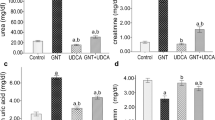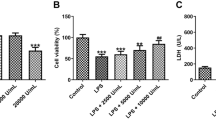Abstract
Broad-spectrum β-lactam antibiotics such as penicillin are routinely used against both Gram-negative and Gram-positive bacteria. However, bacteria that produce β-lactamase have developed resistance against these antibiotics by cleaving the β-lactam ring and rendering the antibiotic inactive. To combat this effect, 1,4,7- Triazacyclononane (TACN), a cyclic organic compound derived from cyclononanes has been shown to preserve the activity of β-lactam antibiotics by inhibiting β-lactamase. However, its cytotoxic effects require elucidation. Given that the cytotoxic target for many therapeutics is the kidney, this study investigated the effects of TACN on human embryonic kidney cells (Hek293) cells. Hek293 cells were treated with TACN (0–500 µM) for 24 h and the cytotoxicity was assessed (MTT and LDH assay). Apoptosis was luminometrically detected by measuring phosphatidylserine externalisation and caspase activity and fluorescently detecting necrosis. DNA fragmentation was visualised using fluorescent microscopy. Expression of the apoptosis-related protein were determined by western blot. The results generated indicate that TACN does not initiate necrosis as LDH was decreased. Likewise, decreased apoptosis was supported by the decreased phosphatidylserine, caspases, Bax, cleaved PARP, IAP and NF-kB. However, increased DNA fragmentation was associated with increased p53. Therefore, effects of TACN at the nucleus, produced a p53 response to initiate DNA repair and did not culminate in cell death. The findings show that TACN is not cytotoxic to Hek293 cells via the apoptotic route. Since TACN did not induce cell death, its potential as a metallo-β-lactamase inhibitor (MBLI) may be exploited to counteract the effect of MBL-producing bacteria. Restoring β-lactam activity will curb the global menace of antibiotic resistance.







Similar content being viewed by others
Data availability statement
The generated data used to support the findings of this study are included within the article.
References
Achilli C, Ciana A, Minetti G (2018) Immortalized HEK 293 kidney cell lines as models of renal cells: friends or foes? J Controv Biomed Res 4:6–9. https://doi.org/10.15586/jcbmr.2018.26
Adams J, Cory S (2007) Bcl-2-regulated apoptosis: mechanism and therapeutic potential. Curr Opin Immunol 19:488–496. https://doi.org/10.1016/j.coi.2007.05.004
Agyepong N, Govinden U, Owusu-Ofori A et al (2019) Genomic characterization of multidrug-resistant ESBL-producing Klebsiella pneumoniae isolated from a Ghanaian teaching hospital. Int J Infect Dis 85:117–123. https://doi.org/10.1016/j.ijid.2019.05.025
Anusha S, Mohan CD, Ananda H et al (2016) Adamantyl-tethered-biphenylic compounds induce apoptosis in cancer cells by targeting Bcl homologs. Bioorg Med Chem Lett 26:1056–1060. https://doi.org/10.1016/j.bmcl.2015.12.026
Baig S, Seevasant I, Mohamad J et al (2016) Potential of apoptotic pathway-targeted cancer therapeutic research: where do we stand? Cell Death Dis 7:e2058. https://doi.org/10.1038/cddis.2015.275
Bezawork-Geleta A, Rohlena J, Dong L et al (2017) Mitochondrial complex II: at the crossroads. Trends Biochem Sci 42:312–325. https://doi.org/10.1016/j.tibs.2017.01.003
Blair JMA, Webber MA, Baylay AJ et al (2015) Molecular mechanisms of antibiotic resistance. Nat Rev Microbiol 13:42–51. https://doi.org/10.1038/nrmicro3380
Brauchle E, Thude S, Brucker SY, Schenke-Layland K (2015) Cell death stages in single apoptotic and necrotic cells monitored by Raman microspectroscopy. Sci Rep 4:4698. https://doi.org/10.1038/srep04698
Castri P, Lee Y, Ponzio T et al (2014) Poly(ADP-ribose) polymerase-1 and its cleavage products differentially modulate cellular protection through NF-kB-dependent signaling. Biochim Biophys Acta - Mol Cell Res 1843:640–651. https://doi.org/10.1016/j.bbamcr.2013.12.005
Dalla Pozza E, Dando I, Pacchiana R et al (2020) Regulation of succinate dehydrogenase and role of succinate in cancer. Semin Cell Dev Biol 98:4–14. https://doi.org/10.1016/j.semcdb.2019.04.013
Désogère P, Rousselin Y, Poty S et al (2014) Efficient synthesis of 1,4,7-triazacyclononane and 1,4,7-triazacyclononane-based bifunctional chelators for bioconjugation. Eur J Org Chem 2014:7831–7838. https://doi.org/10.1002/ejoc.201402708
Devnarain N, Tiloke C, Nagiah S, Chuturgoon AA (2017) Fusaric acid induces oxidative stress and apoptosis in human cancerous oesophageal SNO cells. Toxicon 126:4–11. https://doi.org/10.1016/j.toxicon.2016.12.006
Hafner A, Bulyk ML, Jambhekar A, Lahav G (2019) The multiple mechanisms that regulate p53 activity and cell fate. Nat Rev Mol Cell Biol 20:199–210. https://doi.org/10.1038/s41580-019-0110-x
Hassan M, Watari H, AbuAlmaaty A et al (2014) Apoptosis and molecular targeting therapy in cancer. Biomed Res Int 2014:1–23. https://doi.org/10.1155/2014/150845
Ibeji CU, Lawal MM, Tolufashe GF et al (2019) The driving force for the acylation of β -lactam antibiotics by l,d‐transpeptidase 2: quantum mechanics/molecular mechanics (QM/MM) study. ChemPhysChem 20:1126–1134. https://doi.org/10.1002/cphc.201900173
Jourde-Chiche N, Fakhouri F, Dou L et al (2019) Endothelium structure and function in kidney health and disease. Nat Rev Nephrol 15:87–108. https://doi.org/10.1038/s41581-018-0098-z
Kiraz Y, Adan A, Kartal Yandim M, Baran Y (2016) Major apoptotic mechanisms and genes involved in apoptosis. Tumor Biol 37:8471–8486. https://doi.org/10.1007/s13277-016-5035-9
Koff J, Ramachandiran S, Bernal-Mizrachi L (2015) A time to kill: targeting apoptosis in cancer. Int J Mol Sci 16:2942–2955. https://doi.org/10.3390/ijms16022942
Kumar P, Nagarajan A, Uchil PD (2018) Analysis of cell viability by the lactate dehydrogenase assay. Cold Spring Harb Protocol. https://doi.org/10.1101/pdb.prot095497
Liu L, Ahn KS, Shanmugam MK et al (2019) Oleuropein induces apoptosis via abrogating NF-κB activation cascade in estrogen receptor–negative breast cancer cells. J Cell Biochem 120:4504–4513. https://doi.org/10.1002/jcb.27738
Lussey-Lepoutre C, Hollinshead KER, Ludwig C et al (2015) Loss of succinate dehydrogenase activity results in dependency on pyruvate carboxylation for cellular anabolism. Nat Commun 6:8784. https://doi.org/10.1038/ncomms9784
Ma Z-J, Lu L, Yang J-J et al (2018) Lariciresinol induces apoptosis in HepG2 cells via mitochondrial-mediated apoptosis pathway. Eur J Pharmacol 821:1–10. https://doi.org/10.1016/j.ejphar.2017.12.027
Pfeffer CM, Singh ATK (2018) Apoptosis: a target for anticancer therapy. Int J Mol Sci 19:448. https://doi.org/10.3390/ijms19020448
Ramchuran EJ, Somboro AM, Monaim SAHA et al (2018) In vitro antibacterial activity of teixobactin derivatives on clinically relevant bacterial isolates. Front Microbiol 9:1–10. https://doi.org/10.3389/fmicb.2018.01535
Ramsamy Y, Mlisana KP, Allam M et al (2020) Genomic analysis of carbapenemase-producing extensively drug-resistant Klebsiella pneumoniae isolates reveals the horizontal spread of p18-43 _ 01 Plasmid Encoding bla NDM-1 in South Africa. Microorganisms 8:137
Ramsamy Y, Mlisana KP, Amoako DG et al (2020) Pathogenomic analysis of a novel extensively drug-resistant Citrobacter freundii isolate carrying a blaNDM-1 Carbapenemase in South Africa. Pathogens 9:89. https://doi.org/10.3390/pathogens9020089
Redza-Dutordoir M, Averill-Bates DA (2016) Activation of apoptosis signalling pathways by reactive oxygen species. Biochim Biophys Acta - Mol Cell Res 1863:2977–2992. https://doi.org/10.1016/j.bbamcr.2016.09.012
Rotondo CM, Wright GD (2017) Inhibitors of metallo-β-lactamases. Curr Opin Microbiol 39:96–105. https://doi.org/10.1016/j.mib.2017.10.026
Satyo L, Amoako DG, Somboro AM et al (2020) Molecular insights into Di(2-Picolyl) amine–induced cytotoxicity and apoptosis in human kidney (HEK293) cells. Int J Toxicol 39:341–351. https://doi.org/10.1177/1091581820921180
Somboro AM, Osei Sekyere J, Amoako DG et al (2018) Diversity and proliferation of metallo-β-lactamases: a clarion call for clinically effective metallo-β-lactamase inhibitors. Appl Environ Microbiol 84:1–20. https://doi.org/10.1128/AEM.00698-18
Somboro AM, Amoako DG, Osei Sekyere J et al (2019) 1,4,7-Triazacyclononane restores the activity of β-lactam antibiotics against metallo-β-lactamase-producing enterobacteriaceae: exploration of potential metallo-β-lactamase inhibitors. Appl Environ Microbiol 85:e02077–e02018. https://doi.org/10.1128/AEM.02077-18
Sosibo SC, Somboro AM, Amoako DG et al (2019) Impact of pyridyl moieties on the inhibitory properties of prominent acyclic metal chelators against metallo-β-lactamase-producing enterobacteriaceae: investigating the molecular basis of acyclic metal chelators’ activity. Microb Drug Resist 25:439–449. https://doi.org/10.1089/mdr.2018.0272
Sulkowski PL, Sundaram RK, Oeck S et al (2018) Krebs-cycle-deficient hereditary cancer syndromes are defined by defects in homologous-recombination DNA repair. Nat Genet 50:1086–1092. https://doi.org/10.1038/s41588-018-0170-4
Tiloke C, Phulukdaree A, Gengan RM, Chuturgoon AA (2019) Moringa oleifera aqueous leaf extract induces cell-cycle arrest and apoptosis in human liver hepatocellular carcinoma cells. Nutr Cancer 71:1165–1174. https://doi.org/10.1080/01635581.2019.1597136
Wang S, Gai Y, Zhang S et al (2018) Synthesis and evaluation of a class of 1,4,7-triazacyclononane derivatives as iron depletion antitumor agents. Bioorg Med Chem Lett 28:117–121. https://doi.org/10.1016/j.bmcl.2017.11.048
Yoshizumi A, Ishii Y, Kimura S et al (2013) Efficacies of calcium–EDTA in combination with imipenem in a murine model of sepsis caused by Escherichia coli with NDM-1 β-lactamase. J Infect Chemother 19:992–995. https://doi.org/10.1007/s10156-012-0528-y
Zhang J, Wang S, Wei Q et al (2017) Synthesis and biological evaluation of Aspergillomarasmine A derivatives as novel NDM-1 inhibitor to overcome antibiotics resistance. Bioorg Med Chem 25:5133–5141. https://doi.org/10.1016/j.bmc.2017.07.025
Zhang D, Markoulides MS, Stepanovs D et al (2018) Structure activity relationship studies on rhodanines and derived enethiol inhibitors of metallo-β-lactamases. Bioorg Med Chem 26:2928–2936. https://doi.org/10.1016/j.bmc.2018.02.043
Acknowledgements
The authors are grateful for the financial assistance from the College of Health Sciences, University of KwaZulu-Natal, South Africa.
Author information
Authors and Affiliations
Corresponding authors
Ethics declarations
Conflict of interest
All authors declare no conflict of interest exists.
Ethical approval
Ethical approval was obtained from the Biomedical Research Ethics Administration under the Ref No: BE365/19.
Additional information
Publisher's Note
Springer Nature remains neutral with regard to jurisdictional claims in published maps and institutional affiliations.
Rights and permissions
About this article
Cite this article
Tsotetsi, N., Amoako, D.G., Somboro, A.M. et al. Molecular mechanisms underlying the renoprotective effects of 1,4,7-triazacyclononane: a βeta-lactamase inhibitor. Cytotechnology 72, 785–796 (2020). https://doi.org/10.1007/s10616-020-00422-7
Received:
Accepted:
Published:
Issue Date:
DOI: https://doi.org/10.1007/s10616-020-00422-7




